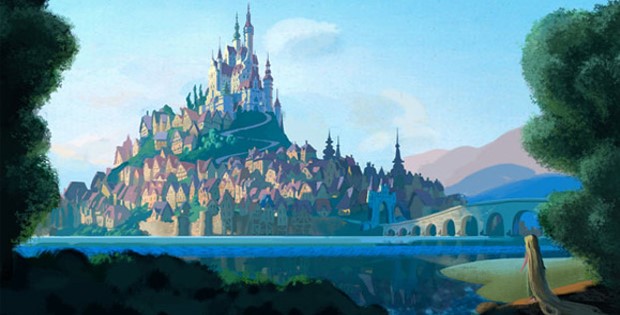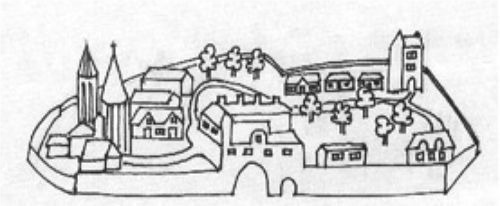Read All About It: Rapunzel, The Middle Ages: Medieval Castles, & Neuschwanstein A Fairy Tale Castle
Rapunzel
Grimm’s Fairy Tale version – translated by Margaret Hunt – language modernized a bit by Leanne Guenther Note: Rapunzel is an old nickname for an herb with leaves like lettuce and roots like a radish — it is also called rampion.

This Photo by Unknown Author is licensed under CC BY-SA-NC
There once lived a man and a woman who always wished for a child, but could not have one. These people had a little window at the back of their house from which a splendid garden could be seen. The garden was full of the most beautiful flowers and herbs. It was, however, surrounded by a high wall, and no one dared to go into it because it belonged to a witch, who had great power and was feared by all the world.
One day the woman was standing by the window and looking down into the garden, when she saw a bed which was planted with the most tasty rapunzel. It looked so fresh and green that she longed for it and had the greatest desire to eat some. This desire increased every day. The woman knew that she could not get any of it and grew more pale and miserable each day.
Her husband was worried about her and asked, “What is wrong my dear?”
“Ah,” she replied, “if I can’t eat some of the rapunzel from the garden behind our house I think I shall die.”
The man, who loved her, thought, “Sooner than let my lovely wife die, I will bring her some of the rapunzel myself, no matter what the cost.”
In the twilight of the evening, he climbed over the wall into the garden of the witch, hastily grabbed a handful of rapunzel and took it to his wife. She at once made herself a salad and ate it happily. She, however, liked it so much — so very much, that the next day she longed for it three times as much as before. If he was to have any rest, her husband must once more descend into the garden. In the gloom of evening, therefore, he set out again; but when he had climbed over the wall, he was terribly afraid, for he saw the witch standing before him.
“How dare you,” she said with angry look, “sneak into my garden and steal my rapunzel like a thief? You shall suffer for this!”
“Ah,” the frightened husband answered, “please have mercy, I had to have the rapunzel. My wife saw it from the window and felt such a longing for it that she would have died if she had not got some to eat.”
Then the witch allowed her anger to be softened, and said to him, “If this is true, I will allow you to take as much as you like, only I make one condition. You must give me the baby daughter your wife will bring into the world; she shall be well treated, and I will care for it like a mother.” The man in his fear consented and when the baby was born the witch appeared at once, gave the child the name of Rapunzel and took the baby away with her.
Rapunzel grew into the most beautiful child beneath the sun. When she was twelve years old, the witch shut her into a tower, which lay in a forest. The tower had no stairs or doors, but only a little window at the very top. When the witch wanted to go in, she stood beneath the window and cried, “Rapunzel, Rapunzel, Let down your hair.”
Rapunzel had magnificent long hair, fine as spun gold, and when she heard the voice of the witch she wound her braids round one of the hooks of the window, and then the hair fell down the side of the tower and the witch climbed up by it.
After a year or two, it came to pass that the Prince rode through the forest and went by the tower. He heard a song which was so lovely that he stood still and listened. This was Rapunzel who in her loneliness passed her time singing. The Prince wanted to climb up to her, and looked for the door of the tower, but none was to be found. He rode home, but the singing had so deeply touched his heart, that every day he went out into the forest and listened to it.
Once when he was standing behind a tree listening to Rapunzel’s song, he saw the witch come and heard how she cried, “Rapunzel, Rapunzel, Let down your hair.” Then Rapunzel let down the braids of her hair, and the witch climbed up to her.
“If that is the ladder by which one mounts, I will for once try my fortune,” thought the Prince and the next day when it began to grow dark, he went to the tower and cried, “Rapunzel, Rapunzel, Let down your hair.”
Immediately the hair fell down and the Prince climbed up.
At first Rapunzel was terribly frightened when a man such as her eyes had never seen, came to her; but the Prince began to talk to her quite like a friend and told her that his heart had been so stirred by her singing that it had let him have no rest. Then Rapunzel lost her fear, and when he asked her if she would take him for her husband — and she saw that he was kind and handsome, she said yes, and laid her hand in his.
She said, “I will willingly go away with you, but I do not know how to get down. Bring a bit of silk with you every time you come and I will weave a ladder with it. When that is ready, I will climb down and we shall escape together.” They agreed that until that time he should come to her every evening, for the old woman came by day.
The witch knew nothing of this, until once Rapunzel said in her distraction, “Oh my, you are so much heavier when you climb than the young Prince.”
“Ah! you wicked child,” cried the witch “What do I hear thee say! I thought I had separated you from all the world but you have deceived me.
” In her anger she clutched Rapunzel’s beautiful hair, seized a pair of scissors — and snip, snap — cut it all off. Rapunzel’s lovely braids lay on the ground but the witch was not through. She was so angry that she took poor Rapunzel into a desert where she had to live in great grief and misery.
The witch rushed back to the tower and fastened the braids of hair which she had cut off, to the hook of the window, and when the Prince came and cried, Rapunzel, Rapunzel, Let down your hair,” she let the hair down. The Prince climbed to the window, but he did not find his dearest Rapunzel above, but the witch, who gazed at him with a wicked and venomous look.
“Aha!” she cried mockingly, “You’ve come for Rapunzel but the beautiful bird sits no longer singing in the nest; the cat has got it and will scratch out your eyes as well. Rapunzel is banished and you will never see her again!”
The Prince was beside himself and, in his despair, he fell down from the tower. He escaped with his life, but the thorns into which he fell pierced his eyes. Then he wandered quite blind about the forest, ate nothing but roots and berries and did nothing but weep over the loss of his dearest Rapunzel.
In this way, the Prince roamed in misery for some months and at length came to the desert where the witch had banished Rapunzel. He heard a voice singing and it seemed so familiar to him that he went towards it. When he approached, Rapunzel knew him and fell into his arms and wept.
Two of her tears fell on his eyes and the Prince could see again. He led her to his kingdom where he was joyfully received, and they lived for a long time afterwards, happy, and contented.
The Middle Ages: Medieval Castles
by ReadWorks
 Illustration by Lynn M. Hanousek
Illustration by Lynn M. Hanousek
Some people assume that medieval castles served as homes for the wealthy and powerful. Although this is true, it is not the whole truth. Castles were communities made up of the wealthy owners, nobles, religious leaders, merchants, and farmers. The building itself was only a part of the castle. Thick walls extended around the castle structure and the village that sat next to the castle.
Castles played an important role in feudalism. The word “castle” comes from a Latin word that means fortress. A castle helped a king or vassal defend the land where the castle stood. It also served as a place to house the king or vassal’s army, weapons, and food. A castle was also the center of local government. Although they were frequently attacked, castles were the safest dwellings of the time. A castle was typically built on the top of a hill to protect the community from invasions. Soldiers on the walls kept a lookout for attacking armies.
Life inside the castle walls was difficult and crowded. There was not much land to build on, so people built houses that were narrow and tall. Many buildings were five or six stories. Streets were also narrow-and dirty. People would throw their garbage and waste out into the streets. Disease spread quickly. At night the streets were dark and unsafe. People would rarely go out after dark without their servants. When they did, they carried torches or candles. Fire was one of the greatest dangers for a medieval town. Most houses were made of wood. Only the wealthy had stone and brick houses. One city in France burned to the ground six times between 1200 and 1255 CE!
Despite the many risks, people lived in castle communities because of the protection that was offered them by the nobles who built the castle and provided military support. Lords and ladies also benefited from the townsfolk who provided food and goods. The castle system was interdependent between the wealthy and the poor. They both needed each other to survive and thrive.
ReadWorks.org · © 2012 ReadWorks®, Inc. All rights reserved.
Neuschwanstein A Fairy Tale Castle

Have you ever wondered where Walt Disney got his idea to build Cinderella’s Castle and Sleeping Beauty’s Castle? When visiting Germany, he and his wife were so impressed by a certain castle, that he designed and built the castle in his theme parks. This castle is Neuschwanstein. If you visit Disneyland or Disney World, you are viewing one of the most famous landmarks in either park.
Key Facts & Information
- The Neuschwanstein Castle sits on a rocky hill above the village of Hohenschwangau in southwest Bavaria, Germany, lying at an elevation of 800 m (2,620 ft).
- Between the 5th and 15th centuries, three castles dominated the villages: Hohenschwangau Castle; it was originally called Schwanstein Castle, Vorderhohenschwangau Castle, and Hinterhohenschwangau Castle.
- In 1864, when King Ludwig II sat on the throne, a new palace was built in place of the two ruined castles, naming it the New Hohenschwangau Castle. It was renamed Neuschwanstein, The new swan rock, after his death.
WHEN WAS NEUSCHWANSTEIN BUILT?
- Construction of Neuschwanstein started during the summer of 1858, demolishing the ruins of the medieval twin castles; however, the first foundation stone was not put in place until September 5, 1869.
- In 1872 to 1876, almost everything up to the first floor of the castle was already completed, even the cellar, but the whole project was expected to be finished within only three years.
- During the latter part of 1882, Neuschwanstein was fully furnished, letting King Ludwig take provisional lodgings and monitor the ongoing construction.
- In 1884, the king was already able to move into the palace, and a year later, he asked his mother, Marie of Prussia, to celebrate her 60th birthday in his newly built castle.
- Neuschwanstein remained incomplete in 1886, when the king died by drowning himself. He only lived in the palace for only 172 days.
WHY WAS NEUSCHWANSTEIN BUILT?
- King Ludwig II, also known as the mad king, earned a reputation for being a whimsical and unsociable ruler, making it clear why Neuschwanstein is sometimes called “the castle of the fairy tale king”.
- Some assume that the king built the castle for political and personal reasons.
- In the 1886 Austro-Prussian War, Prussia won and forced Bavaria to create an alliance with the empire, causing King Ludwig II to lose his power in the throne.
- Others believe that Neuschwanstein turned into the highlight of Ludwig’s imagined kingdom, where he could envision himself as a true monarch.
WHAT DOES THE NEUSCHWANSTEIN CASTLE LOOK LIKE?
- Neuschwanstein is a castle of paradox – it was constructed when castles were no longer needed as refuge, and, despite its romanticized medieval architecture, Ludwig II ordered to have all the contemporary technological comforts.
- The castle design was drafted by designer Christian Jank and approved by architect Eduard Riedel.
- The grand palace is complete with a walled courtyard, an indoor garden, spires, towers, and a man-made cave. It also has running water, including flushing toilets and hot water in the kitchen and baths, and even a forced-air central heating system.
- The dining area has an elevator from the kitchen which is three floors below. The king also ensured Neuschwanstein was connected to telephone lines.
- A Byzantine basilica was the inspiration of Neuschwanstein’s two-story throne room. Stars filled its blue vaulted ceiling, which is bolstered by red porphyry (igneous rock with feldspar crystals) columns.
- German dramatic composer Richard Wagner was highly admired by King Ludwig II. The wall paintings of the whole castle showed the legends that influenced Wagner: the story of Parsifal in the fourth-floor Singer’s Hall, the adventures of Tannhauser in the study, and Lohengrin in the great parlor.
- Neuschwanstein remained unfinished. According to the blueprints, the castle was supposed to have more than 200 rooms. But just over 14 rooms were finished before the budget cut.
INSPIRATION FOR DISNEY FAIRY TALES
- Rumors say that the Neuschwanstein Castle is the real-life inspiration for the palaces in the Disney classic movie, Cinderella in 1950.
- Others also believe that Sleeping Beauty’s castle in Disneyland has quite a resemblance with the Neuschwanstein

